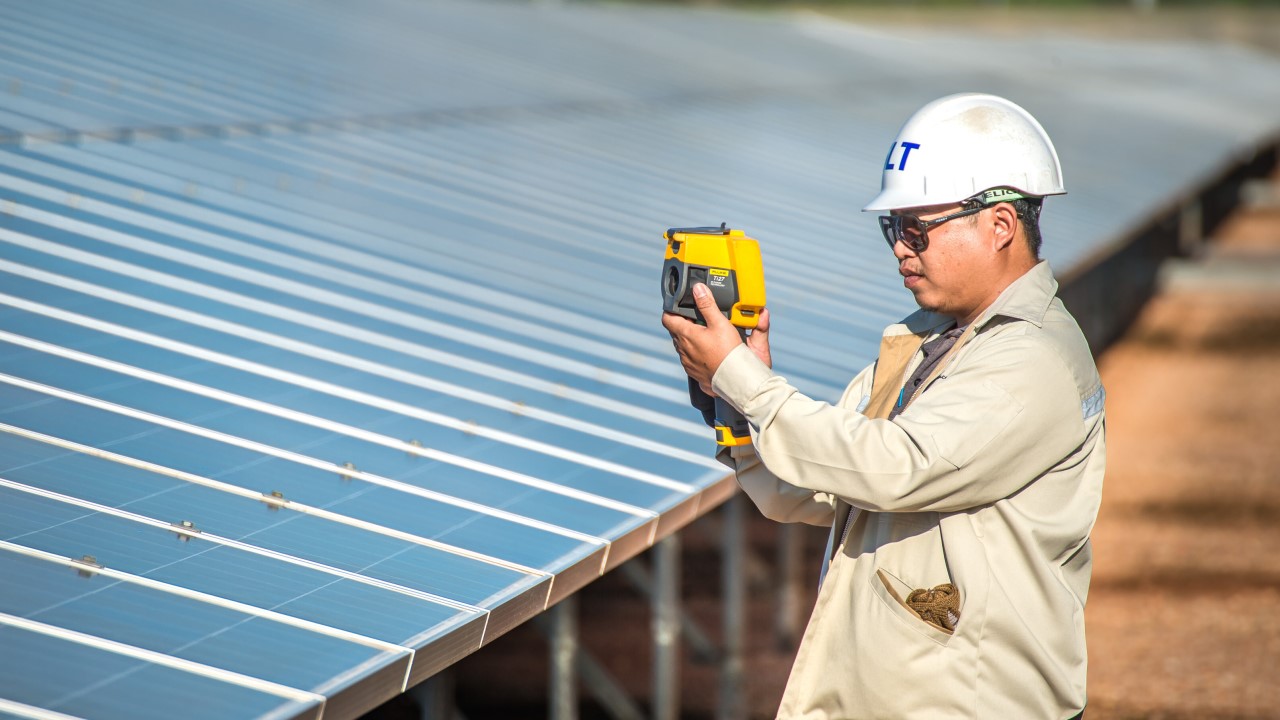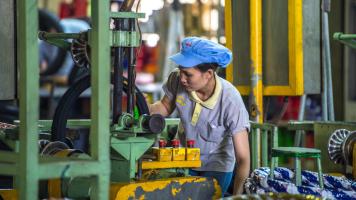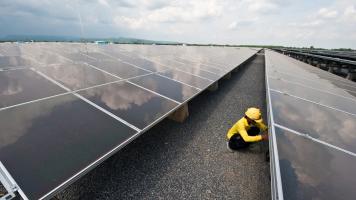
Southeast Asia's current capacity for solar PVs accounts for 9%–10% of global cell and module production, with bulk of the supply coming from Malaysia, Thailand, and Viet Nam. Photo credit: ADB.
To unlock these opportunities, however, the region needs joint action from multiple stakeholders to provide regulations, standards, manufacturing sector reforms, and other initiatives.
The global push to decarbonize by 2050 presents huge opportunities for Southeast Asia in the manufacture of solar photovoltaic (PV) panels, electric two-wheelers, and batteries, where the region has room to grow in both production capacity and demand.
In the presentation, “Southeast Asia to Scale Up Renewable Energy Manufacturing,” at the Asian Development Bank's (ADB) Southeast Asia Development Symposium (SEADS), McKinsey Asia Sustainability Practice Partner and Leader Vaibhav Dua estimated there is $160 billion to $200 billion worth of annual revenue opportunities in green businesses in the region by 2030. Unlocking these opportunities could translate to 6 million new jobs in the region by 2050.
Globally, the energy transition could create $7 trillion to $10 trillion worth of opportunities and up to 30 million new jobs, he said.
"These opportunities are real," said Dua. "The region can be at the forefront of this change," he urged, citing the region's strength in manufacturing. "Manufacturing is not something that is new to us in the region. Manufacturing represents a core part of our GDP [gross domestic product]. It's a backbone that we have had for a long time,” he said.
He said though joint action is needed from multiple stakeholders to realize ASEAN's full potential in scaling renewable energy manufacturing.
Strengths and opportunities
Solar PVs. Many of the countries in the region already have capacity in making the basic components in making solar panels, such as polysilicon, wafer, and solar PV cells. Current capacity accounts for 9%–10% of global cell and module production, with bulk of the supply coming from Malaysia, Thailand, and Viet Nam. Demand will likely double in the next 8 years.
Electric two-wheelers. The region has 2.8 million units worth of capacity for two-wheelers, accounting for 6%–10% of the global capacity estimated at 25 million to 30 million. The market is expected to increase 15 times as penetration levels in some countries are still in the lower single digit. Demand for two-wheelers or motorcycles in the region is already strong, particularly in Indonesia and Viet Nam. With global demand for electric vehicles seen increasing by 2040 with countries setting their vehicle electrification target close to 100%, Southeast Asia has the potential to become a regional hub for electric motorcycles.
Batteries. The region accounts for only 0.5% of the global capacity for batteries. However, Southeast Asia has a strong potential to boost capacity, as 25% of the global reserve for nickel, a key raw material for making batteries, is found in the region.
Given Southeast Asia’s strengths in the three segments, Dua said international players have forayed into the region in search of opportunities. Local players have also entered the ecosystem, which is important in disrupting traditional business models.
But Southeast Asia needs “unlocks,” said Dua. He said joint action is needed from government; industry; international, multilateral, and funding organizations; and nongovernment organizations, manufacturing associations, philanthropies, research organizations, and the academe in setting regulations, standards, manufacturing sector reforms, and other initiatives that will encourage the growth of the region’s renewable energy manufacturing sector.
Establishing strategic partnerships
Sustainable Energy for All CEO Damilola Ogunbiyi urged Southeast Asian countries to build the next generation of renewable energy manufacturing and industrial capabilities to meet local demand as well as play a central role in the regional supply chain. “Strategic partnerships must therefore be formed to facilitate cooperation among ASEAN countries to catalyze the growth of the renewable energy sector in this region through a coordinated approach and build up or scale up renewable energy manufacturing capabilities.”
Ogunbiyi said ADB, Sustainable Energy for All, Bloomberg Philanthropies, and ClimateWorks Foundation will partner with Southeast Asian countries to scale renewable energy manufacturing capabilities.
ClimateWorks Foundation Global Energy Transition Initiative Director Rui Luo said a whole-of-government approach is needed to scale up the region’s renewable energy manufacturing sector. Governments and companies must also prepare the workforce for the jobs that will be created should countries scale up their renewable energy manufacturing sectors.
ADB Director General and Sectors Group Chief-Designate Ramesh Subramaniam also recognized the sector’s potential, adding partnership is going to be key going forward, as well as providing the enabling environment for the private sector. “There is a role for the public sector to play, but a lot of things need to happen in the private sector side. We need an ecosystem. We need that enabling environment.”

